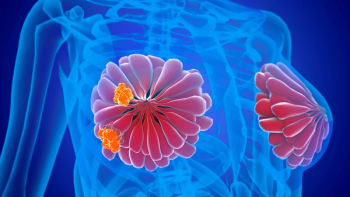
Intravesical Mitomycin Produces 24-Month Response in Recurrent NMIBC
New data showed a 72.2% DOR rate in patients with recurrent low-grade, intermediate-risk non–muscle-invasive bladder cancer who had a CR at 3 months.
Updated data from the phase 3 ENVISION trial (NCT05243550) revealed durable long-term responses in adult patients with recurrent low-grade, intermediate-risk non–muscle-invasive bladder cancer (NMIBC) treated with mitomycin intravesical solution (Zusduri).1
Data announced by UroGen showed that at a median follow-up of 23.7 months among patients who achieved a complete response (CR) at 3 months (79.6%), the Kaplan‑Meier–estimated 24‑month duration of response (DOR) rate was 72.2% (95% CI, 64.1%-78.8%). The median DOR had not been reached at the time of analysis.
“This latest update from the pivotal ENVISION trial of [mitomycin] showed that, among patients who achieved a CR at 3 months, the probability of remaining event-free 24 months after CR was 72.2%,” Sandip Prasad, MD, MPhil, director of genitourinary surgical oncology and vice chair of urology at Morristown Medical Center/Atlantic Health System in New Jersey, and principal investigator of the ENVISION trial, stated in a news release.1
In June 2024, the
"Among patients who achieved a CR, the event rate over time has remained stable. This DOR result highlights the sustained efficacy of the therapy and reinforces its potential as a durable treatment option,” Prasad added. “For the first time, adult patients with recurrent NMIBC have an FDA-approved therapy. This marks a potentially transformative step forward in how we manage this chronic, highly recurrent, and disruptive cancer.”
ENVISION Trial Breakdown
ENVISION was a single‑arm, multinational, multicenter pivotal study designed to evaluate the efficacy and safety of mitomycin for intravesical solution in patients 18 years and older with low-grade NMIBC requiring transurethral resection of bladder tumor.3 Patients also needed to have intermediate-risk disease, defined by the presence of multiple tumors, a solitary tumor greater than 3 cm, or early/frequent recurrence (at least 1 episode within 1 year of the current diagnosis). Negative voiding cytology for high‑grade disease within 8 weeks of screening was also necessary. Additional requirements included adequate organ and bone marrow function and an anticipated life expectancy sufficient to complete the study.
Eligible participants received 6 once‑weekly intravesical instillations of mitomycin at 75 mg.
The primary end point was the CR rate at 3 months after the first instillation. The key secondary end point was the DOR over time among patients who achieved CR at the 3‑month assessment. Other secondary end points included disease-free survival and safety.
Safety Analysis
The most common adverse effects reported in at least 10% of patients, including laboratory abnormalities, were dysuria, increased potassium levels, increased creatinine levels, decreased hemoglobin levels, increased eosinophils counts, increased aspartate aminotransferase levels, increased alanine aminotransferase levels, decreased lymphocyte counts, urinary tract infection, decreased neutrophil counts, and hematuria.1
Most AEs were mild to moderate in severity. Serious AEs occurred in 12% of patients, with the most frequently reported events being urinary retention (0.8%) and urethral stenosis (0.4%).
“The 24-month DOR data from the ENVISION trial underscore the transformative potential of [mitomycin] for adult patients with recurrent NMIBC,” Mark Schoenberg, MD, chief medical officer of UroGen, added in the news release.1 This is a population that has long endured a cycle of recurrence and repeat surgeries, a burden that weighs heavily, particularly on older adults. With [mitomycin] now approved, we have a new treatment option that can help deliver durable complete responses and meaningfully extend event-free intervals. This represents a major advance in the way we care for these patients.”
References
- UroGen announces 24-month duration of response of 72.2% from the pivotal phase 3 ENVISION trial of Zusduri, the first and only FDA-approved medicine for recurrent low-grade intermediate-risk non-muscle invasive bladder cancer. News release. UroGen. August 5, 2025. Accessed August 05, 2025. https://investors.urogen.com/news-releases/news-release-details/urogen-announces-24-month-duration-response-722-pivotal-phase-3
- FDA approves mitomycin intravesical solution for recurrent low-grade intermediate-risk non-muscle invasive bladder cancer. FDA. June 12, 2025. Accessed August 5, 2025. https://www.fda.gov/drugs/resources-information-approved-drugs/fda-approves-mitomycin-intravesical-solution-recurrent-low-grade-intermediate-risk-non-muscle
- A phase 3 single-arm study of UGN-102 for treatment of low-grade intermediate-risk non-muscle invasive bladder cancer (ENVISION). ClinicalTrials.gov. Updated November 4, 2024. Accessed August 5, 2025. https://clinicaltrials.gov/study/NCT05243550
Newsletter
Knowledge is power. Don’t miss the most recent breakthroughs in cancer care.




















































































